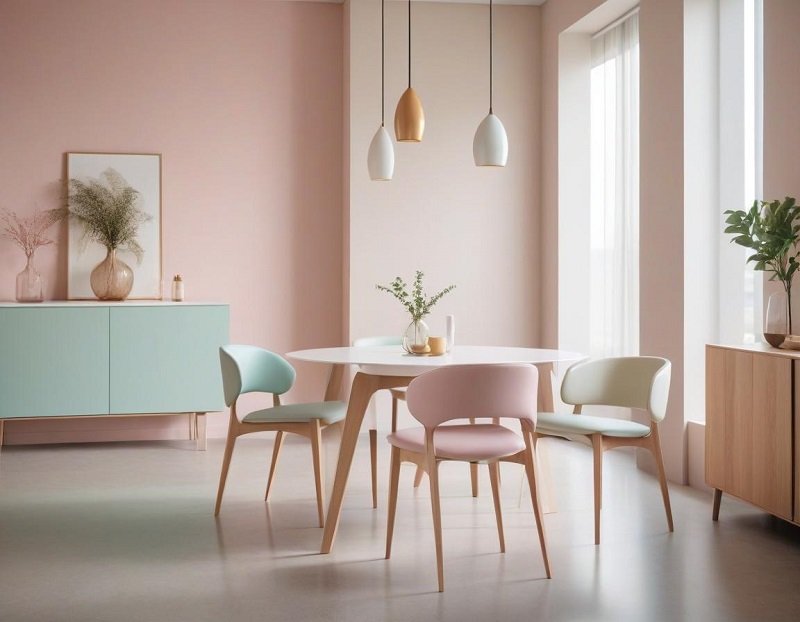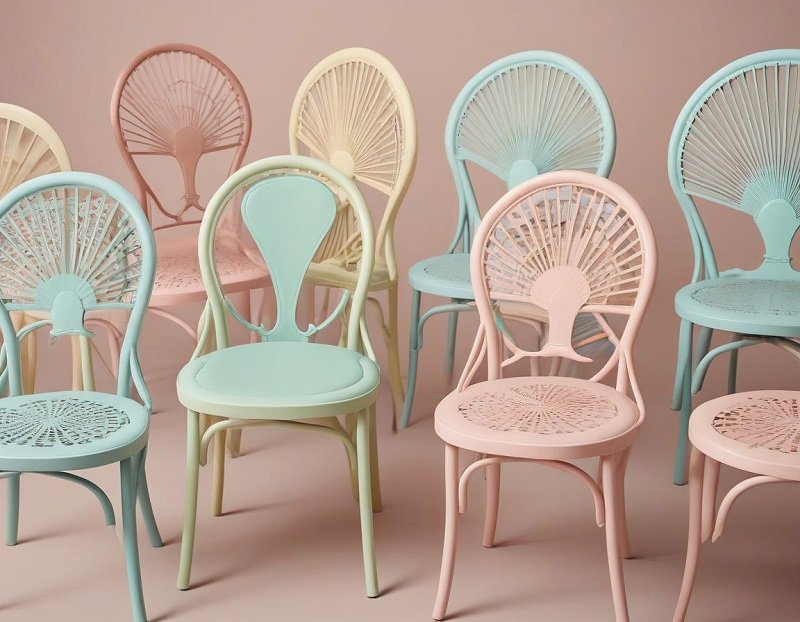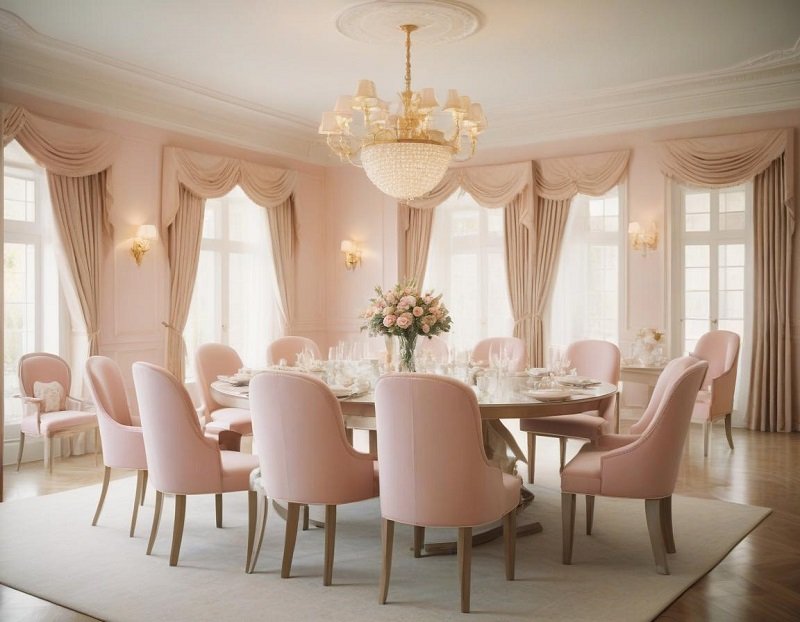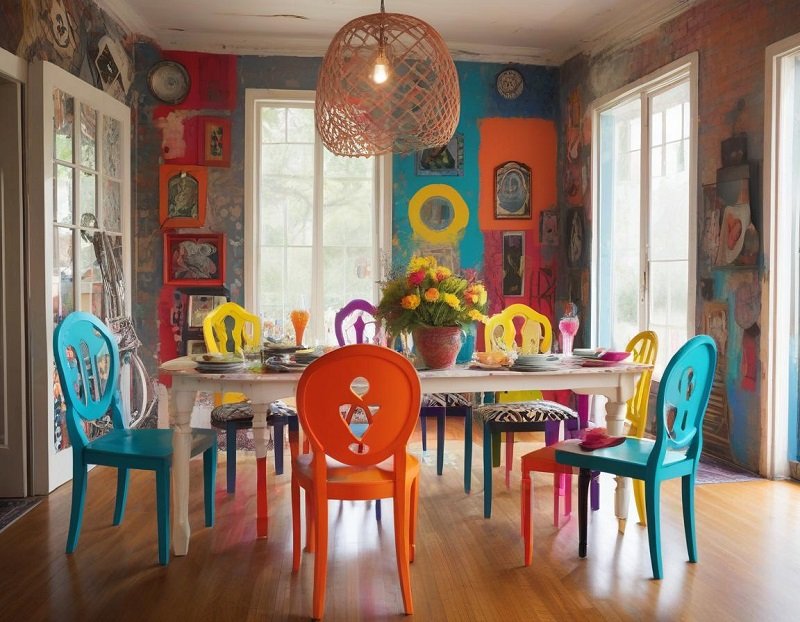Blog
What Are the Different Types of Dining Chairs?

Introduction
When we think of the heart of our house, many of us picture the dining room—a place where the scent of a home-cooked dinner fills the air, tales are spoken, and laughter resonates across the table. The dining table, which is generally the focal point of this space, stores not only the food we consume but also the memories we make. While the dining table frequently receives all the attention, the chairs that surround it are equally significant. These chairs are more than simply seats; they combine comfort and elegance, functionality and design.
Remember the last time you had visitors around for supper? You probably concentrated on the food, the table setting, and maybe even the lighting. But have you noticed the chairs? Did you consider how they complement the table, and how they feel while you sat for hours over a long meal? The reality is that the perfect dining chairs can take your dining set from practical to great, providing an attractive setting that encourages guests to remain and enjoy the moment for a little longer.
In this article, we’ll look at the many types of dining chairs available and help you select the best match for your dining set. Whether you want to renew your present setup or start from scratch, learning the many types, materials, and designs available can help you make a decision that matches both your preferences and your lifestyle.
Types and Categories of Dining Chairs
As you start on the adventure of finding the ideal dining chairs, it is critical to understand the many types and categories available. The world of dining chairs is broad, with options ranging from simple and understated to luxurious. Let’s start by breaking down some of the most frequent sorts you’ll come across, each with its own distinct flavor to add to your dining set.
Side Chair
Imagine entering a room with a nicely arranged dining table and fine yet unassuming chairs. These are side chairs, the adaptable workhorses of dining rooms. Side chairs are the most popular style of dining chair, and they are usually arm-less, making them suitable for fitting around any table. The appealing look of side chairs comes from their simplicity. They don’t draw attention, but they complete the dining set in a way that seems balanced and harmonious.
Side chairs are also quite practical. Without arms, they may simply slide beneath the table, conserving space and keeping the dining area neat. This makes them perfect for smaller dining sets or those who desire a more streamlined appearance. And because they come in so many different styles—from cushioned seats for additional comfort to hardwood seats for a more traditional feel—side chairs can be fitted to any aesthetic.
Armchair
If side chairs are reliable workhorses, armchairs are the centerpieces. Placing an armchair at the head of your table may elevate your dining set to a level of distinction and style. Armchairs, with their added structure, frequently provide a feeling of formality and elegance to the dining experience. Armchairs instantly indicate a more formal dining environment, making them excellent for people who like throwing fancy dinner parties or simply want to add a touch of luxury to their daily meals.
However, armchairs are more than simply stylish; they also provide exceptional comfort. The armrests give support, making these seats ideal for relaxed meals that turn into extended chats. In an open-concept setting, armchairs may also function as a transition piece between the dining area and the living room, anchoring the dining set inside the larger space.
Host and Hostess Chairs
Host and hostess chairs elevate the idea of armchairs, sometimes including even more elaborate designs and luxury materials. These chairs are typically positioned at the ends of the table, reserved for the head of the home or important visitors, lending a sense of grandeur to the dining set.
Even in less formal situations, host and hostess chairs may provide a sense of distinction. For example, in a modern dining set, these chairs may have sleek designs and modern fabrics, separating them from the simpler side chairs while retaining a unified appearance.
Dining Chair Heights: The Perfect Fit
Selecting the appropriate dining chair height is critical for both comfort and aesthetics. If the height of your dining chairs does not match your table, the complete dining set may feel fragmented or unpleasant. Most dining tables are 28-30 inches tall, while the average seat height for dining chairs is 18-20 inches. This balance guarantees that there is adequate room for your legs while also allowing you to sit comfortably at the table.
What if your dining set isn’t standard? For tables that are higher or shorter than typical, you will need to find matching seats. Adjustable-height chairs may be a versatile option, accommodating a variety of demands.
In addition to the seat height, consider the chair’s back height. A tall, high-backed chair can give a more formal, dramatic appearance, whilst a lower back height may be more appropriate for a casual or minimalist dining set. The idea is to choose a chair that complements the overall proportions of your dining set, resulting in a harmonious and appealing atmosphere.
Chair-Back & Design
The shape of a dining chair’s back contributes significantly to its visual appeal and comfort. The back of the chair not only maintains your posture but also adds to the overall look of your dining set. Here, we’ll look at a range of chair-back designs, each with its unique personality and use for your dining room.
1- Bow Back: The Timeless Curve
The bow back design is a classic, with a softly curved backrest in the shape of a bow. This design is commonly found on Windsor chairs, a style that has been popular for decades. The bow back offers good support, making it a great choice for extended feasts and parties.
2- Cross Back: The Charming Accent
The cross-back design, which is commonly linked with French rural or farmhouse designs, has two diagonal supports that cross at the back of the chair. This design gives a sense of charm and refinement to any dining set, making it a popular choice for those wishing to give their room individuality.
3- Cut-out Back: The Modern Twist
The cut-out back design adds a fresh, modern touch to the look for people who value a contemporary style. These chairs have backrests with deliberately positioned cut-outs that add a sensation of openness and lightness. The cut-out design may range from simple geometric forms to more elaborate patterns, letting you select a style that matches your dining set.
4- Fan Back: The Radiating Elegance
The fan back design features a set of spindles that extend from the seat to the top of the chair, like a fan. This pattern is commonly seen in classic or colonial-style dining sets and is renowned for its elegance and timeless charm.
5- Floating Arms: The Contemporary Flair
Floating armchairs mix the comfort of armchairs with the clean lines of modern design. In this form, the arms are not linked to the chair legs, creating the illusion that they are floating. This design is great for those who prefer a minimalist look but want the comfort of armrests.
6- Keyhole: The Unique Detail
Keyhole back chairs have a characteristic keyhole-shaped cut-out in the backrest, which adds a unique and decorative aspect to the chair’s design. This design is adaptable and may be seen in both conventional and contemporary dining sets, depending on the form and size of the keyhole.
7- King Louis: The Regal Influence
King Louis chairs, inspired by the grandeur of French royalty, are recognizable by their oval or round backs, complex carvings, and luxurious fabric. These chairs provide a feeling of elegance and refinement to any dining set, making them ideal for formal dining rooms.
8- Ladder Back: The Rustic Charm
Ladder back chairs have horizontal slats that run across the backrest, like a ladder. This design is often linked with rural or farmhouse themes and is known for its simplicity and longevity.
9- Lattice Back: The Intricate Pattern
Lattice back chairs have an interlaced pattern of slats or bars on the backrest, resulting in a lattice-like look. This form is both beautiful and supportive, making it a popular choice for those looking to add an air of sophistication to their dining set.
10- Live Edge: The Natural Beauty
Live edge chairs embrace the natural contours and imperfections of the wood, allowing the tree’s original shape to guide the design. This design is great for individuals who admire nature’s beauty and wish to add a rustic, earthy vibe to their dining set.
11- Low Back: The Subtle Elegance
Low-back chairs have a shorter backrest, resulting in a more open appearance. This design is suitable for smaller dining rooms or those who like a minimalist style.
12- Open Back: The Airy Design
Open back chairs have a backrest with open areas, resulting in a light and airy look. This design is great for modern or contemporary dining sets that value clean lines and simplicity.
13- Parsons: The Clean and Versatile
Parsons chairs are distinguished by their simple, clean lines and completely upholstered appearance. They are quite adaptable and may be used in a variety of dining set designs, including conventional and modern.
14- Queen Anne: The Graceful Curve
Queen Anne chairs are defined by their graceful, flowing shape and cabriolet legs. This style is commonly linked with classic or antique dining sets, and it adds a feeling of elegance and refinement to the dining room.
15- Sheaf Back: The Rustic Appeal
Sheaf back chairs have a backrest design that imitates a bundle of wheat or sheaves, linked together in the middle. This design is commonly linked with country or farmhouse dining sets, and it lends a bit of rustic character to the space.
16- Slat Back: The Simple Strength
Slat back chairs have vertical slats running across the backrest, which provide both support and simplicity. This design is commonly found in classic or mission-style dining sets and is known for its longevity and simple charm.
17- Solid Back: The Sturdy Support
Solid back chairs have a backrest formed of a single piece of material, which provides robust support and a clean, uninterrupted design. This style is adaptable and may be seen in both classic and modern dining sets.
18- Splat Back: The Decorative Detail
Splat back chairs have a central, decorative element called a splat—a vertical panel in the backrest that is typically sculpted or carved to provide interest. This style is typical in classic or antique dining sets, and it provides an air of refinement to the environment.
19- Tufted: The Luxurious Comfort
Tufted chairs have upholstered backs with buttons or stitching to produce a tufted, cushioned appearance. This style is frequently linked with elegance and comfort, making it an excellent choice for formal or glamorous dining sets.
20- Turnbuckle: The Industrial Edge
Turnbuckle chairs include visible hardware, such as bolts or metal bracing, which gives them an industrial, tough appearance. This style is perfect for people who like an edgy, urban vibe in their dining set.
21- Two-tone: The Contrasting Colors
Two-tone chairs combine two distinct colors or finishes, resulting in a dramatic contrast that adds visual interest to the dining set. This design is adaptable and may be found in both classic and modern settings.
22- Upcycled: The Eco-friendly Choice
Upcycled chairs are created from reused or repurposed materials, which gives them a distinct, eco-friendly appearance. This design is ideal for folks who are environmentally conscious and wish to implement sustainable methods in their house.
23- Upholstered: The Plush Comfort
Upholstered chairs include cushioning and fabric on the seats and backrests, providing a pleasant and luxurious seated experience. This pattern is quite adaptable and may be seen in a variety of styles, including classic and modern.
24- Windsor: The Traditional Craftsmanship
Windsor chairs are distinguished by their spindle backs and turned legs, a form that has been popular for generations. This design is frequently linked with classic or colonial dining sets, adding a feeling of craftsmanship and antiquity to the dining area.
25- Wingback: The Dramatic Flair
Wingback chairs have high backs with “wings” that extend from the sides, lending a dramatic and luxurious appearance. This style is frequently linked with classic or formal dining sets, and it provides a sense of grandeur to the space.
26- Wraparound: The Embracing Comfort
Wraparound chairs have a backrest that bends around the sides, providing a sensation of enclosure and relaxation. This style is great for those who appreciate comfort and want to create a warm and pleasant eating environment.
Conclusion
Choosing the proper dining chairs is more than simply finding a place to sit; it’s about building a dining set that reflects your taste, fits your comfort needs, and adds to the overall mood of your dining room. Whether you like the timeless beauty of a Windsor chair, the modern flare of a cut-out back, or the elegant comfort of an upholstered chair, there is a dining chair to suit every room.
Consider how each of the different types, materials, and designs will complement your dining table, the aesthetic of your space, and, most importantly, how it will make you and your guests feel. After all, the dining room is where memories are built, and the appropriate dining chairs may help create an environment in which those memories will be treasured for years to come.
FAQs
1- How do I choose the right dining chair height?
Choosing the right height for your dining chairs is crucial for both comfort and aesthetics. As a general rule, the seat of your dining chair should be about 10-12 inches lower than the height of your dining table. For example, if your dining table is 30 inches high (which is standard), your chairs should have a seat height of around 18-20 inches.
When choosing chairs, also consider the thickness of any cushions or upholstery, as these can slightly alter the effective seat height. If you have a non-standard table height, adjustable dining chairs or custom chairs might be the best solution to ensure everyone can sit comfortably.
2- Can I mix and match different types of dining chairs?
Absolutely! Mixing and matching different types of dining chairs can add a unique, eclectic touch to your dining set. To ensure a cohesive look, consider these tips:
- Stick to a common theme: For example, choose chairs with a similar color palette or material, even if the designs differ.
- Balance with symmetry: If you’re mixing styles, try to maintain balance by placing matching chairs at each end of the table or alternating between different styles around the table.
- Consider the table: Ensure that the various chair designs complement the dining table. For instance, pairing a rustic table with modern chairs can create an interesting contrast, but the overall style should still feel harmonious.
3- What’s the best material for dining chairs in a high-traffic home?
For homes with children, pets, or frequent dinner parties, durability and easy maintenance are key considerations. Here are some material recommendations:
- Wood: Solid wood chairs, especially those with a durable finish, are a classic and long-lasting option. They’re easy to clean and can withstand daily use.
- Metal: Metal chairs are incredibly durable and can add an industrial or modern touch to your dining set. They’re also easy to wipe clean.
- Upholstered chairs with removable covers: If you love the comfort of upholstered chairs, consider ones with removable, washable covers. This allows you to keep the chairs looking fresh even in a busy household.
4- How can I ensure my dining chairs are comfortable for long meals?
Comfort is key, especially if you often host dinner parties or enjoy long, leisurely meals. Here are some factors to consider:
- Seat cushioning: Chairs with padded seats or added cushions can significantly enhance comfort. Memory foam cushions are particularly comfortable.
- Ergonomic design: Look for chairs with a supportive backrest, preferably with a slight recline or ergonomic curve that supports the natural curve of the spine.
- Armrests: Armchairs or host/hostess chairs at the head of the table can provide extra comfort, especially during long dinners.
5- Are upholstered dining chairs difficult to maintain?
Upholstered dining chairs can add a luxurious touch to your dining set, but they do require some maintenance to keep them looking their best. Here are some tips:
- Choose stain-resistant fabric: Look for fabrics that are treated to resist stains and spills, such as microfiber or treated cotton.
- Use fabric protectors: Apply a fabric protector to your chairs to create an additional barrier against stains.
- Regular cleaning: Vacuum your upholstered chairs regularly to remove dust and crumbs. For spills, blot (don’t rub) immediately and follow the manufacturer’s cleaning instructions.
6- How can I incorporate dining chairs into a small dining space?
In a small dining space, every inch counts. Here are some tips for choosing dining chairs that maximize space without compromising on style or comfort:
- Opt for low-back chairs: Low-back chairs take up less visual space, making the room feel more open.
- Consider armless chairs: Armless chairs can be pushed completely under the table when not in use, freeing up floor space.
- Choose transparent or slim designs: Clear acrylic chairs or those with a slim profile can make a small space feel less crowded while still providing adequate seating.
7- What’s the difference between side chairs and armchairs in a dining set?
Side chairs are armless chairs that typically sit alongside the longer sides of a rectangular dining table. They’re versatile and take up less space, making them ideal for smaller dining rooms or where seating capacity is a priority.
Armchairs, on the other hand, have arms and are usually placed at the ends of the table. They offer additional comfort and a more formal appearance, often seen in traditional dining sets. Incorporating both side chairs and armchairs can add variety and enhance the dining set’s overall appeal.
8- How do I care for wooden dining chairs?
Wooden dining chairs are a timeless choice, but they do require some care to maintain their beauty and durability:
- Regular dusting: Use a soft, dry cloth to dust your chairs regularly, preventing dirt buildup.
- Avoid direct sunlight: Prolonged exposure to direct sunlight can cause wood to fade or crack. If possible, place your dining set away from direct sunlight or use window treatments to block harsh rays.
- Clean spills immediately: Wipe up spills as soon as they occur to prevent staining or damage to the wood finish.
- Polish occasionally: Depending on the finish, use a wood polish or wax to maintain the luster and protect the surface from scratches.
9- Can I use outdoor dining chairs indoors?
Yes, you can use outdoor dining chairs indoors, especially if you’re going for a casual, rustic, or eclectic look. Many outdoor chairs are made from durable materials like metal, rattan, or weather-resistant wood, which can bring a unique texture and style to your indoor dining set. Just ensure the chairs are comfortable and proportionate to your dining table.
Using outdoor chairs indoors can also be a practical choice in homes with young children or high traffic, as they tend to be more durable and easy to clean.
10- How do I know if my dining chairs will support my dining set’s aesthetic?
To ensure your dining chairs complement your dining set and overall room design, consider the following:
- Match the style: If your dining table is traditional, choose chairs with classic elements like carved wood or tufted upholstery. For a modern table, look for chairs with clean lines and a minimalistic design.
- Coordinate materials: Try to match or complement the material of the chairs with the table. For example, wooden chairs with a wooden table or metal chairs with a glass table.
- Balance the room: Consider the room’s color scheme, furniture, and overall style when selecting dining chairs. The chairs should enhance the room’s design, not clash with it.









